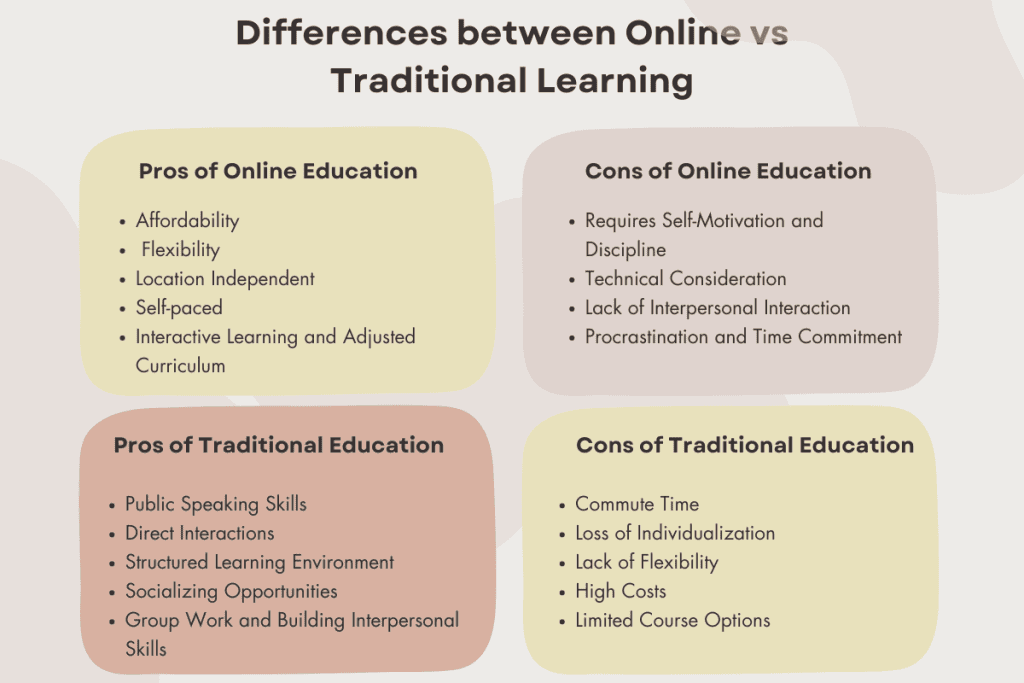When you think about online education, you probably associate it with higher education or college.
However, online K-12 education has been available in the USA for 20 years and it is now quickly expanding globally.
We will analyze what are the differences between online learning and the traditional setting in K-12 education (and in education in general) and which are the pros and cons of both.
Differences between Online Learning vs Traditional Learning

The effectiveness of online learning compared to traditional education depends on factors like student preferences, technology development, and courses taken.
Traditional classroom involves physical attendance and face-to-face interactions between teachers and students. This provides an excellent opportunity to build a sense of community, socialize, and receive feedback.
On the other hand, online education offers more flexibility and convenience to fit learning into your busy schedule.
Online learning has several names, including online schooling, remote learning, online education, distance learning or e-learning.
Pros of Online Education
Did you know that online learning has grown more than 900% since its inception in the early 2000-s, according to Oxford College research.
The main difference between traditional and online education is that the first one forces students to fit into it.
In contrast, online education caters to different learning styles and adapts to each student.
Let’s consider learning outcomes in an K-12 online programs vs traditional learning.

Affordability and Cost Efficiency
Firstly we need to consider the cost of online learning vs traditional learning. Online education’s cost-effectiveness has a significant advantage.
Students can save money on:
- accommodation;
- travel;
- food;
- physical textbooks;
- and learning materials.
This may result in substantial financial savings, especially for students living in remote, distant areas.
Additionally, our school, EduWW, has several tuition fee packages that fit different family budgets and allow families to pay in monthly installments.
Flexibility and Self-Paced Learning
Online learning offers greater flexibility and autonomy. Students can choose courses according to their interests and goals, without location, time, or curriculum limitations. This can be very helpful for those who need flexible schedules.
Online learning also allows students to learn at their own pace and create a schedule that works best for them. This method of teaching adapts to the individual needs of each learner.
Apart from that, this approach also enables students to concentrate on topics and tasks that are either interesting or challenging to them.
They can also manage their time better, making room for non-school activities like training professional sports, dancing classes, or music activities.
Our school, EduWW, uses adaptive technology to help students learn more efficiently. This technology evaluates each student’s performance and provides resources and feedback to address their individual needs.
It also has built-in tools and instructions that are helpful and useful. This is especially important for supporting children with learning difficulties.
It offers students the freedom to learn at their own pace and convenience. This nourishes effective time management skills by emphasizing relevant material.
Organizing time efficiently is essential for university later in life, and children need to start developing this skill at a young age.
Location Independence
Another advantage of online learning is that it erases geographical boundaries.
Online education allows people worldwide to access data, information, and quality education equally.
Whether from small developing nations or London suburbs, students can study from the comfort of their homes.
Our school has a mix of students from around the world, creating a welcoming and diverse learning environment.
Multicultural environment provides our students with a safe space to share knowledge and experiences and learn about different nations.
Interactive Learning
Learning in online K-12 schools has become more exciting and accessible with interactive platforms with videos, games, quizzes, and assignments.

These platforms just like the one we use in our school are easy to use and make it possible to learn a lot in a short amount of time. Interactive, dynamic elements, audio and visuals help learners understand new concepts.
All necessary information, articles, materials, resources, and assignments are presented through games, audio recordings, and video clips.
This offers wide range of choices for students with different learning styles.
For instance, visual learners can watch pre-recorded videos or graphics and photos, while auditory learners can listen to an audio lesson instead of reading it.
Likewise, students can explore additional resources or use different tools such as a translator or dictionary that can provide an additional help.
Some lessons even contain external links if learners want to learn more about a specific subject.
Adjusted Curriculum
Tutors closely monitor students’ progress, adjusting the pace of learning and adapting the curriculum. This approach helps students receive individualized attention and support, leading to better learning outcomes.
Although each grade at our school officially spans 10 months, online students have the freedom to complete it up to two months earlier or take additional time, depending on arrangements made with their consultants and tutors.
The curriculum consists of core and elective subjects. Online schools offer a much wider choice of electives because they are not bound by the number of students that attend them.
That allows online students to study something they genuinely like or are passionate about. In high school, these electives can be a solid foundation for future studies.
We also have four core subjects – Language Arts, Mathematics, Science, and Social Studies. There is also a number of specific subjects that allow students to specialize in their areas of interest.
Immediate Feedback Benefit
With online learning you get immediate feedback on your child progress through courses.
Likewise, the student gets almost instant results on most quizzes and assessments. That prompt response helps students access their own knowledge and improve.
Besides this feedback on the platform, parents can always book a meeting with an assigned tutor to discuss their child’s progress and future actions that will improve their grades, something much less efficient with traditional schools.
24/7 Access to Learning Materials
With 24/7 access to learning materials, online schooling offers a learning experience beyond the traditional school day.
Students can access the material whenever they want and revisit it anytime. That is excellent for students with different study rhythms because the school adapts to them, not vice versa.
This non-stop accessibility of the learning materials is a fundamental part of online K-12 education’s flexibility that allows students to pursue hobbies or have other obligations that will not interfere with the schooling schedule.
Cons of Online Learning
Now that we have discussed the advantages of online schooling, let’s explore all its downsides.
Requires Self-Motivation and Discipline
Because of specific challenges, online learning may be less effective than in-person classes.
These include difficulties with self-motivation and discipline, procrastination, loss of interest, laziness, and time constraints.
Addressing these issues is essential so students can make the most of their online learning experience.
Teachers in traditional classrooms are responsible for presenting lectures in an exciting and motivating way. They need to capture their students’ attention and encourage them to learn.
This involves creating a stimulating and engaging learning environment. In contrast, in some online K-12 schools, the student determines the learning process.
In our online K-12 school, tutors actively participate in each student’s learning process.
They carefully observe students’ progress and work with them to ensure their commitment and motivation during the semester.

Technical Consideration
The cost of technical equipment or a lack of website or platform optimization may be the issue for some.
However, it doesn’t always have to be this way. Our online school is easy to join; you just need a compatible device and a reliable internet connection.
After that, you can log in from anywhere in the world and start building your way to academic achievements!
Our platform is a complete learning management system (LMS) that offers a stable, engaging, and efficient learning experience.
Lack of Interpersonal Interaction
Traditional classrooms often offer more opportunities for students to socialize.
In an online school, students often need more formal discussions, group work, and classroom interactions to make up for all that.
At our school, we offer group classes, where students can learn while socializing with others.
We also have student clubs and councils, allowing students to explore their interests and meet their peers.
Pros of Traditional Education

Now, let’s explore the benefits of traditional learning vs online.
Group Work, Socializing and Building Interpersonal Skills
Traditional classes offer many opportunities to develop interpersonal skills through activities like public speaking, group projects, class presentations, and face-to-face discussions.
These experiences help students build confidence, work effectively in teams, and receive immediate feedback from teachers.
In-person interactions also make it easier to build professional relationships and social connections, which are important for future success. Being physically present in a school setting naturally supports this kind of growth.
As an online K-12 school, we know the importance of this and take steps to bridge the gap. Our teachers actively nourish strong connections with students, ensuring they feel supported and engaged, not isolated.
Communication is a priority and students can reach out via chat or email. Our teachers are committed to responding promptly and consistently, often more quickly than in traditional settings.
To support social and academic development, our school’s platform was designed to include these important elements, just in a digital format.
Structured Learning Environment
Traditional education often uses a set schedule and a standard curriculum for the sake of clear and organized learning.
This structure helps make sure important topics are taught in the right order and that everyone learns the same key skills.
It also allows teachers to check progress regularly and give helpful feedback. Students benefit from learning with their peers and having support from teachers.
While self-paced online learning gives more freedom and flexibility, it can be harder to stay motivated and keep up without a set routine.
For many students, the structure of traditional schools provides the guidance and consistency they need to succeed.
Cons of Traditional Education
After exploring its benefits, let’s look at traditional education’s downsides.
Commute time
Traditional education forces students to be physically present, which can take a lot of their time and resources.
Having to worry about traveling to and from school means they can spend less time on other activities they love.
Loss of Individualization
In conventional classrooms, professors face the challenge of balancing the progress of a large number of students.
This can lead to a loss of individualization and make it difficult for students to receive the attention they need.
At our school, we ensure tutors are always available for every student. Students can schedule 1-on-1 sessions whenever they need extra support.
Our tutors offer personalized academic assistance, including homework help, exam preparation, and general academic guidance.

Lack of Flexibility
The learning process in a physical classroom follows a predetermined schedule, a standardized curriculum, and a fixed location.
Students receive a weekly timetable with their classes and expected attendance times.
Missing a class would result in the student being unable to participate in that particular lesson.
It’s possible but difficult for students to catch up with missed lessons. This can ultimately lead to a decline in the overall quality of learning.
On the other hand, online learning and LMS platforms allows students to revisit each lesson as often as needed.
High Costs & Limited Course Options
Cost of private education plays a vital role when deciding between traditional vs online learning.
Generally, traditional schooling involves higher expenses, such as living costs, food, textbooks, and transportation.
Traditional schools offer a limited range of courses due to resource constraints and administration.
Online courses allow students to study various courses outside their hometown or living area.
This gives students more flexibility to learn and access courses from all over the world, all from the comfort of their homes.
Conclusion

Finally, everyone’s experience with traditional education and online learning is different.
There are pros and cons on both sides of the spectrum that make them unique and effective in different learning situations.
Some prioritize flexibility and accessibility, while others value social interaction and a standardized learning approach.
You can feel confident about your education no matter which route you choose. Colleges place the same value on a degree, whether it is earned online or not.



